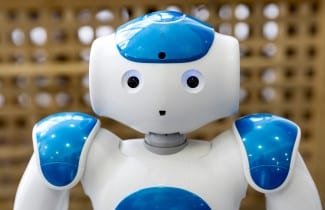Will the Robots Take Over? A History of Automation

In The Turn of the Key, a recent thriller by Ruth Ware, a nanny is tormented by the technology in the smart home where she works—she is under constant surveillance by cameras, woken in the middle of the night by booming music over the speaker system, and literally left in the dark when the lights shut off at the most perilous moments.
Interestingly, Ware’s novel is a take on The Turn of the Screw, an 1898 horror tale by Henry James, in which a nanny works in a house that appears to be haunted. Ware’s version, though, augments human terror about the supernatural with anxieties about advanced technology.
While this fearful fascination with automation feels very “now,” its roots extend a long way back, even to ancient Greece, and it has been a key component in human development throughout the centuries.
Our ideas about automation have also become increasingly important. Automation and artificial intelligence (AI) continue to advance in Canada, with both federal and provincial governments funneling money into research and technology adoption.
In December of 2018, for instance, the federal government announced nearly $230M in funding to the AI-Powered Supply Chains Supercluster (SCALE.AI).
Given this vigorous focus in the Canadian tech sector, alongside ongoing worries from some people about the potential negative results of automation, it’s worth looking at past innovations in automation and artificial intelligence in order to better understand where we might be headed.
Magic & Motorcars: The History of Automation
Automatons & Other Stories
 The notion of automation has its roots in Greek myth: Hephaestus, the god of metalworking (yes, there was a god for that), created metal statues that he animated to help him in his forge and home. While the automatons were moved by magic rather than technology, such stories point to an early human notion of giving inanimate objects the power of movement in order to complete simple, repetitive tasks.
The notion of automation has its roots in Greek myth: Hephaestus, the god of metalworking (yes, there was a god for that), created metal statues that he animated to help him in his forge and home. While the automatons were moved by magic rather than technology, such stories point to an early human notion of giving inanimate objects the power of movement in order to complete simple, repetitive tasks.
Much later, in the 11th century, people put this concept into practice when they developed the earliest actual machines, in relation to mining, where workers used water wheels to power draining machines. By the 17th century, mechanization took a leap forward with the invention of a horse-powered lathe for making cannons. In the 1800s, the widespread use of steam power fueled the rise of factories.
“What We Need is More Automation”: The 20th Century
In the summer of 1948, the Ford Motor Company was setting up machines for a new model and was trying to determine the best way to load and unload parts that would pass between machines. Delmar S. Harder, an engineering manager at Ford, declared, “What we need is more automation.” It was the first recorded use of the term.
After that, the word automation became popularly used, in both the automotive sector and other sectors, and developments in industrial automation continued at a fast pace.
Canada’s Innovations in Automation
In the 20th century, Canada also made significant contributions to automation.
One of the first industrial robots in North America is reported to have been in a candy factory in Kitchener, Ontario, in the early 1960s.
Now, in the 21st century, Canadian manufacturers increasingly replace manual labour with automation, driven by a need for greater precision, higher speeds, and lower costs. The Province of Ontario, in fact, recently opened the Ontario Automotive Modernization Program to help automotive manufacturers reduce operational costs through new processes and technologies.
The Government of Canada, as well, has emphasized that Canada’s manufacturing sector will be able to compete with lower cost labour markets through innovation—developing new technologies and processes that will provide cost efficiency.
The Rise of the Machines: The History of AI & Robots
Teach Your Robot to Smoke, & Other Lessons
Robots, as a specific type of automation, are crucial to the evolution in manufacturing and other sectors. The term robot was coined by Karel Capek in his 1920 play, Rossum’s Universal Robots, in which worker robots rebel against humanity.
Despite this early panic about robots, automation continued to develop in the 20th century: Elektro, a robot created by Westinghouse Electric Corporation, appeared at the World’s Fair in 1939. Elektro was 210 cm tall and had a vocabulary of 700 words, delivered by way of a 78RPM record-player housed in its body.
In response to human commands, Elektro could walk, talk, blow up balloons, count on its fingers, and (how useful) smoke cigarettes.
In 1948, William Grey Walter created two robotic tortoises, Elmer and Elsie, which could maneuver their way around obstacles by responding to touch and light; and in 1961, Unimation introduced the first robotic arm to automobile manufacturing.
Only My Chatbot Understands Me: Artificial Intelligence
Around the same time, AI began to take hold. While automated machines could perform specific tasks repeatedly based on configurations provided by humans, AI aimed to get machines to act more like humans. The Turing Test, developed by Alan Turing in 1950, examined a machine’s ability to exhibit intelligent behaviour indistinguishable from that of a person.
One of the first programs capable of attempting the Turing Test was ELIZA, a chatbot created by Joseph Weizenbaum at MIT in the 1960s. Among other things, ELIZA simulated the behaviour of a psychotherapist and convinced some users that they were receiving text responses from a real person.
Canada’s Global Leadership
Canada’s best-known contribution to robotics is probably the Canadarm, first used by the crew of the NASA space shuttle Columbia in 1981 and employed on later missions to remotely construct the International Space Station. Since then, Canada’s expertise in the field has increased dramatically, becoming a world leader in AI and robotics. Ontario alone is home to more than 350 automation and robotics-related companies, and University of Toronto professor Geoffrey Hinton has been called the “godfather of AI” for his work in machine learning.
As well, the Quebec-based SCALE.AI Supercluster recently announced an investment of $5.1M in three projects that apply AI to supply chains.
Canada’s western provinces are also making key innovations. In Saskatchewan, for example, remote presence robots allow doctors to see patients in under-serviced rural and remote populations, and in BC, Canada’s Digital Technology Supercluster is developing an AI-powered medical imaging network to connect points of care for skin cancer patients.
Driving the Future
 Critics of automation and artificial intelligence have expressed concerns about resulting job losses, which even the Bank of Canada admits is a possibility for some workers. However, in the long term, the data suggests that employment will actually increase. Automation generates gains that can boost employment, as greater productivity can lead to increased sales and increased investments in Canadian operations. Manual labour will be replaced with more highly skilled positions in R&D, programming, and other areas.
Critics of automation and artificial intelligence have expressed concerns about resulting job losses, which even the Bank of Canada admits is a possibility for some workers. However, in the long term, the data suggests that employment will actually increase. Automation generates gains that can boost employment, as greater productivity can lead to increased sales and increased investments in Canadian operations. Manual labour will be replaced with more highly skilled positions in R&D, programming, and other areas.
But what about those fears of the robots taking over the world, or tormenting us in our own homes, as in Ware’s novel? Perhaps those kinds of fears are driving one of the most interesting developments in AI: its growing relationships to the arts and humanities.
Gillian Hadfield, the inaugural director of the Schwartz Reisman Institute for Technology and Society, writes of the tech environment in Toronto:
“We are a place where nobody thinks that technology owns the future, and where people have not given up on the idea of smart policy or smart governance to ensure no one is left behind in this revolution.”
Hadfield sees AI and robotics leveraged not only for economic power, but, if social and legal structures can keep pace, for social good as well.
To learn more about resources that can fuel the growth of automotive and technology businesses, please download Mentor Works’ Electric and Autonomous Vehicle Trends white paper.


